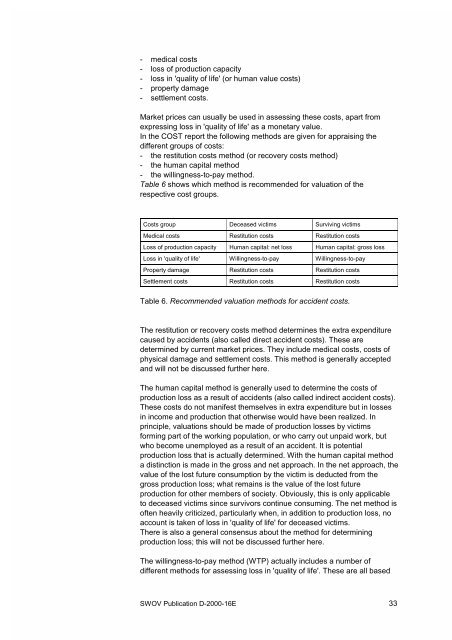Economic evaluation of road safety measures - Swov
Economic evaluation of road safety measures - Swov
Economic evaluation of road safety measures - Swov
Create successful ePaper yourself
Turn your PDF publications into a flip-book with our unique Google optimized e-Paper software.
- medical costs<br />
- loss <strong>of</strong> production capacity<br />
- loss in 'quality <strong>of</strong> life' (or human value costs)<br />
- property damage<br />
- settlement costs.<br />
Market prices can usually be used in assessing these costs, apart from<br />
expressing loss in 'quality <strong>of</strong> life' as a monetary value.<br />
In the COST report the following methods are given for appraising the<br />
different groups <strong>of</strong> costs:<br />
- the restitution costs method (or recovery costs method)<br />
- the human capital method<br />
- the willingness-to-pay method.<br />
Table 6 shows which method is recommended for valuation <strong>of</strong> the<br />
respective cost groups.<br />
Costs group Deceased victims Surviving victims<br />
Medical costs Restitution costs Restitution costs<br />
Loss <strong>of</strong> production capacity Human capital: net loss Human capital: gross loss<br />
Loss in 'quality <strong>of</strong> life' Willingness-to-pay Willingness-to-pay<br />
Property damage Restitution costs Restitution costs<br />
Settlement costs Restitution costs Restitution costs<br />
Table 6. Recommended valuation methods for accident costs.<br />
The restitution or recovery costs method determines the extra expenditure<br />
caused by accidents (also called direct accident costs). These are<br />
determined by current market prices. They include medical costs, costs <strong>of</strong><br />
physical damage and settlement costs. This method is generally accepted<br />
and will not be discussed further here.<br />
The human capital method is generally used to determine the costs <strong>of</strong><br />
production loss as a result <strong>of</strong> accidents (also called indirect accident costs).<br />
These costs do not manifest themselves in extra expenditure but in losses<br />
in income and production that otherwise would have been realized. In<br />
principle, valuations should be made <strong>of</strong> production losses by victims<br />
forming part <strong>of</strong> the working population, or who carry out unpaid work, but<br />
who become unemployed as a result <strong>of</strong> an accident. It is potential<br />
production loss that is actually determined. With the human capital method<br />
a distinction is made in the gross and net approach. In the net approach, the<br />
value <strong>of</strong> the lost future consumption by the victim is deducted from the<br />
gross production loss; what remains is the value <strong>of</strong> the lost future<br />
production for other members <strong>of</strong> society. Obviously, this is only applicable<br />
to deceased victims since survivors continue consuming. The net method is<br />
<strong>of</strong>ten heavily criticized, particularly when, in addition to production loss, no<br />
account is taken <strong>of</strong> loss in 'quality <strong>of</strong> life' for deceased victims.<br />
There is also a general consensus about the method for determining<br />
production loss; this will not be discussed further here.<br />
The willingness-to-pay method (WTP) actually includes a number <strong>of</strong><br />
different methods for assessing loss in 'quality <strong>of</strong> life'. These are all based<br />
SWOV Publication D-2000-16E 33
















